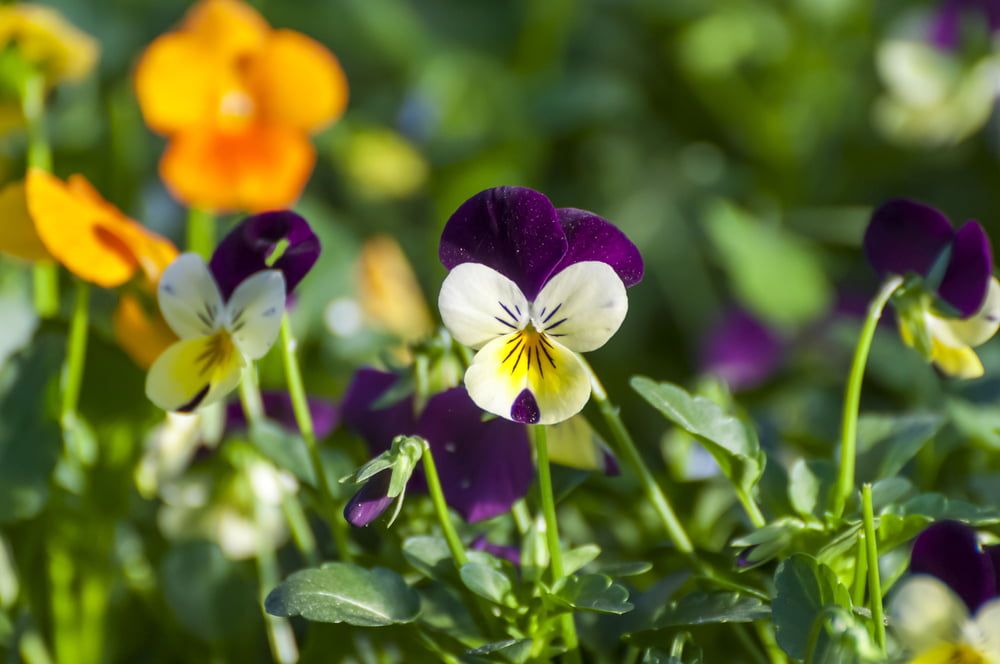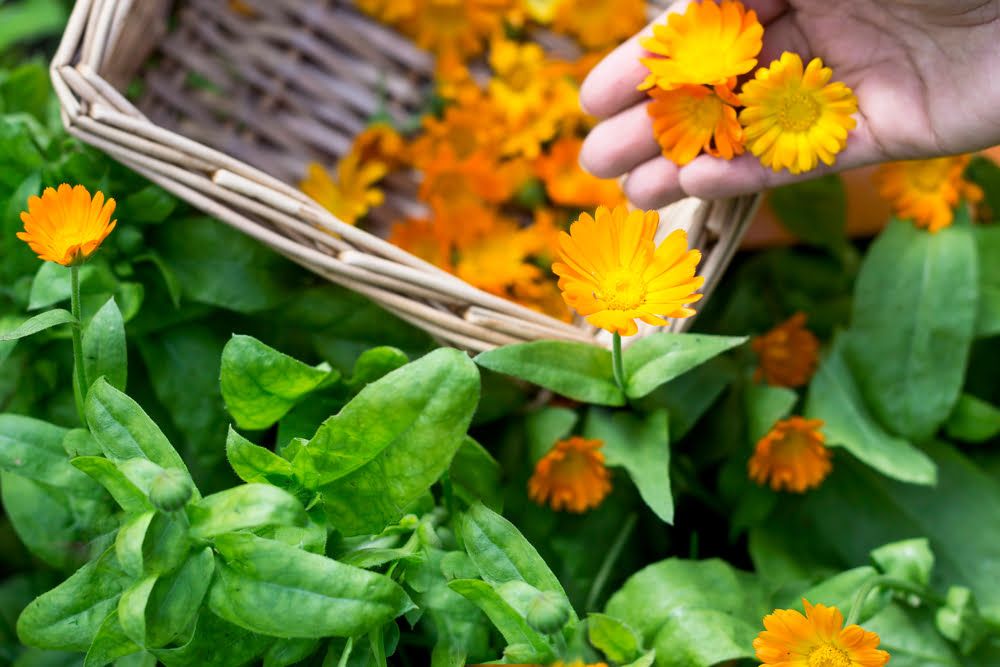
While edible flowers used as a garnish can make even the dullest dish look more interesting, it’s not solely about appearances. Flowers are packed with a wide range of vitamins, minerals, and antioxidants, making edible flowers a tasty and nutrient-rich addition to any meal.
Which Edible Flowers Should You Grow?
There are so many different edible flowers out there, and some are much easier to grow than others. It would be impossible to list them all, so, instead, here are some of the most flavourful and colourful edible flowers that you could grow:
To Sow in Jan-Apr:
Carnation
- Spacing: 20-25cm
- Depth: 2cm
- Harvest: Jun-Oct. Only the petals are edible – they taste surprisingly sweet and clove-like.
Bee Balm
- Spacing: 45-60cm
- Depth: 0.2cm
- Harvest: May-Oct. The leaves and flowers taste like a cross between mint and oregano. Each variety has its own unique flavour.
Lavender
- Spacing: 30-90cm
- Depth: 0cm
- Harvest: May-Sep. All varieties are edible, but some are much stronger than others. All parts of the plant are edible.
To Sow in Feb-Apr
Pansy
- Spacing: 15cm
- Depth: 1.5cm
- Harvest: May-Oct. Winter-flowering varieties are available too. The flowers have a delicately sweet flavour. Some varieties even taste a little like bubblegum.
Viola
- Spacing: 20-30cm
- Depth: 0.5cm
- Harvest: May-Oct. The entire plant is edible, with a sweet, lettuce-like flavour.
Borage
- Spacing: 30cm
- Depth: 1.5cm
- Harvest: Jun-Oct. The flowers, leaves, and stems are loved for their mild, cucumber-like flavour.
To Sow in Mar-May
Calendula
- Spacing: 15-20cm
- Depth: 1-2cm
- Harvest: Jun-Oct. Both the leaves and flowers are edible, with a bitter yet more-ish flavour. When dried, the flowers taste quite nutty.
Chamomile
- Spacing: 20cm
- Depth: 0.5cm
- Harvest: Jun-Sep. The flowers have a floral, honey-like sweetness to them. When dried, they’re almost like a crisp apple.
Cornflower
- Spacing: 30cm
- Depth: 1.2cm
- Harvest: Jun-Sep. The flowers taste slightly spicy, with a clove-like sweetness.
To Sow in Mar-Jun
Sunflower
- Spacing: 30-80cm
- Depth: 1.5cm
- Harvest: Aug-Sep. Sunflowers are usually harvested for their seeds, which are deliciously tender and nutty.
Nasturtium
- Spacing: 30cm
- Depth: 1.5cm
- Harvest: Jun-Oct. All parts of the plant are edible. They have a spicy, peppery flavour, although the flowers are noticeably sweeter.
Hollyhock
- Spacing: 60cm
- Depth: 0.5cm
- Harvest: Jun-Sep. The flowers, leaves, and seed pods have a flavour that’s similar to cress.
How to Grow Edible Flowers at Home
Each edible flower species that you grow will have its own set of growing requirements. Once you have made a list of your chosen flowers, spend some time researching what each plant needs when it comes to sun, temperature, and soil.
Fortunately, when it comes to actual growing techniques, you can grow just about every edible flower in the same way.
Companion Planting with Edible Flowers
While a bed dedicated solely to edible flowers would definitely be a colourful sight, many gardeners also choose to companion plant with edible flowers, mixing them through their other plants.
Many edible flowers help to deter common fruit and vegetable pests, while also brightening up a vegetable garden.
A few popular combinations include:
- Borage planted with strawberries, tomatoes, cabbages, and squash
- Calendula planted with mint and sage
- Nasturtiums planted with beans, brassicas, tomatoes, and potatoes
- Chamomile planted with mint, basil, brassicas, and beans
- Lavender planted with carrots and leeks
How to Grow Edible Flowers from Seed
It’s easy enough to buy edible flowers as plug or young plants and then transplant them into your garden. However, not only is this method significantly more expensive than growing them from seed, but it will also really restrict you in terms of different varieties.
Varieties are key when it comes to edible flowers. Most varieties are developed for their ornamental appeal, so do some research into the best edible varieties of each of your chosen flowers. Once you do, you’ll likely find that these are much easier available as seeds than as potted plants.
When sowing your seeds, it’s always best to start edible flowers in module trays or small pots. This minimises root disturbance when transplanting.
How to Sow Edible Flower Seeds:
- Fill your module trays with a multi-purpose compost
- Water well, checking that excess water can easily drain out from underneath
- Sow your seeds into each module. Make sure that you check how deep they need to be for the different species you’re growing – some need a few cm, while others need to be sown on the surface. Aim for 2-3 seeds per module
- Label each tray, or insert plant markers, so that you know which flowers are which, since chances are that you’ll be sowing multiple species at the same time
- Lightly mist your modules to dampen the seeds from above, and then place your trays in a suitable location. Again, some flowers require more heat than others during the germination process, so make sure that you check on this
Germination times will vary depending on the species. Once your seeds have germinated, keep them consistently moist. No matter which flowers you’re growing, seedlings should never be allowed to dry out.
After a week or so, thin your seedlings out so that there’s just one plant growing in each module.
Depending on how quickly your seedlings grow, you may need to transplant them into a larger pot before planting them out. Never allow them to get root bound – as soon as you notice the first few roots emerging from the drainage holes, it’s time for a new pot.
How to Plant Edible Flowers Outside
Most edible flowers, even the perennials, should only be planted outside once all risk of frost has passed. While some may be frost-hardy when established, young plants are much more delicate.
For this reason, make sure that you also harden your seedlings off before moving them to their new home. This means leaving them outside for a couple of hours on the first day, and then a couple of hours more on the second day, and so on. After a week or so of doing this, they should have happily spent the night outside, while still in their pots. At this stage, they’re ready to be planted.
How to Plant Edible Flowers:
- Prepare your planting area by removing any weeds or plant debris and amending the soil if necessary
- Dig planting holes that are deep enough to accommodate your plants, along with the soil from the pot or module they are growing in. Check the recommended spacing for the specific flowers you’re growing, so that you know how far apart each of your planting holes should be
- Place each of your flower plants into a hole. Then, cover them back over with soil, firm the soil down, and water well
How to Plant Edible Flowers in a Greenhouse
Growing edible flowers in a greenhouse allows you to extend your growing season by quite a bit. Your plants will bloom earlier in the year, and, so long as you ensure optimum conditions, they’ll continue flowering until the end of autumn.
Planting methods are the same as when planting outside. However, you’ll need to pay closer attention to ventilation. If your greenhouse flowers end up too over-crowded, diseases will soon take hold. Make sure that there is plenty of air circulation in your greenhouse to prevent this from happening.
How to Care for Edible Flowers
Most edible flowers are easy to care for. Once they’ve established in the ground, they’ll need very little attention, especially if you’re regularly harvesting the flower heads.
Watering Edible Flowers
Watering can be tricky if you’re growing a bed of mixed flowers. Some plants will need more, while some will need less.
As a general rule of thumb, never allow the soil to fully dry out. Try to keep the soil consistently moist, but not soggy. Watering lightly and regularly is better for most flowers than a deep and heavy watering session less frequently.
Feeding Edible Flowers
Again, different flowers have different fertiliser needs, but a general-purpose fertiliser will usually be sufficient for all. This ensures that your plants are receiving enough nitrogen for leafy growth, along with potassium for flower production, plus a range of trace elements.
You won’t need to feed your flowers often. One application in the spring, followed by another in mid-summer, is all they require.
Mulching Edible Flowers
It won’t take long for weeds to start showing up in your flowerbed. They’ll compete with your flowers for nutrients, water, and light, and will often physically smother out smaller flower plants.
To save yourself from having to spend hours weeding, make sure that you mulch all of your edible flower plants. This will prevent weeds from emerging, as well as blocking new weed seeds from setting root around your plants. Organic mulches are the best way to go, since these will also feed the soil as they break down.
How to Harvest Edible Flowers
It couldn’t be easier to harvest edible flowers. Simply wait until your flowers are in bloom, before snipping off what you need.
Many often feel guilty harvesting their most beautiful flowers, wanting to keep them on the plants to decorate their garden instead. While there’s nothing with your edible flowers also providing ornamental value, most species will actually produce even more blooms if their flowers are regularly picked.
How to Store Edible Flowers
Edible flowers are best used fresh. They’ll start wilting pretty much immediately after being picked, meaning that they won’t last for long in a fridge either.
However, if you want a long-term storage option for your edible flower harvest, consider drying your flowers. A food dehydrator works perfectly for this.
Drying the flowers allows them to retain their shape and colour. Store them in an air-tight container and they’ll be good to use for several months.
Edible flowers can also be frozen. The most common way to do this is by freezing the flowers in ice cube trays, along with water. The floral cubes are then used in drinks.
How to Prepare & Cook Edible Flowers
Most flowers are extremely delicate, so don’t hold up to the heat of being cooked. For this reason, they’re most commonly used as a garnish for meals and drinks, as well as in salads.
Here are a few ideas of what you could do with your edible flower harvest:
- Create a syrup/cordial from the petals
- Mix them with yoghurt for breakfast
- Use them to decorate cakes
- Make some candied flowers
- Infuse them into a jelly
- Make a floral butter
- Dry them and brew them into a tea
Common Edible Flower Problems
The pests and diseases that you’ll experience while growing edible flowers will depend on the flower species you’re growing. If you notice that anything looks amiss, take a closer look at your plants and note down specific symptoms. A little research should help you to identify exactly what the problem is.
Don’t forget that it’s usually the weaker plants that succumb to pests and diseases. Keeping your plants in good health and ensuring that all of their requirements are met will give them the strength and vigour that they need to stay healthy.
Conclusion
Not only do edible flowers hold value as a culinary ingredient, but they also attract pollinators while injecting a dose of colour and vitality into their growing area. Whether you choose to mix your edible blooms in with the other plants you’re growing, or decide to dedicate an entire bed to tasty florals, edible flowers are a fantastic addition to any garden.










